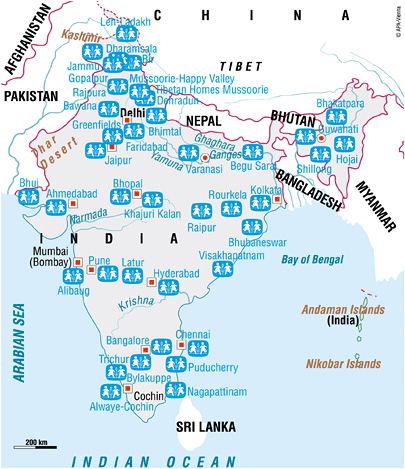
SOS relies on the kindness and generosity of Canadians to be able to provide a home for the most vulnerable children of India.
By becoming a child sponsor you are helping an individual child in need.
(You will receive a Canadian charitable tax receipt)
Please help us ensure a loving home for every Indian child. Sponsor a child in India now.
SOS Children's Villages in Bir
In order to support the Tibetan population that had settled in Bir, SOS Children's Villages decided to become active here. The SOS Children's Village provides day-care, primary and secondary education, as well as family-based care. SOS Children's Villages for Tibetans generally have many more inhabitants than other SOS Children's Villages due to the large number of Tibetan refugees.
Children who have lost parental care can live in one of the 20 SOS families alongside their brothers and sisters. Due to the great number of orphaned and abandoned children, SOS families may have up to thirty members and sometimes even more. Young people live in special accommodation, while they start vocational training or go on to higher education. With the support of qualified professionals they are guided through this new stage of their lives.
Young children from the SOS village and from surrounding families go to the SOS Kindergarten. Having a place where a professional looks after their children while they are at work or receive training makes life easier for parents. As the children grow older, the SOS school allows them to receive primary and secondary schooling in accordance with their Tibetan beliefs.

Supporting Tibetans in exile
The SOS Children's Village for Tibetans in Bir is located in the small village of Suja, which is about 50 kilometres south-east of Dharamsala.
The local population consists mainly of poor Indian farmers. Since 1966 Bir has also been home to Tibetan refugees. Back then, families, who were mostly from the Kham region in eastern Tibet, were given land on which they could build houses. The Bir Tibetan Settlement (which is also known as the Bir Tibetan Colony) developed to include religious and cultural sites. Many people living in the settlement have been born and raised here. Children from Tibet are often sent here by their parents who see this as the only way that their child will obtain a Tibetan education.
Many tourists, both from other areas of India and from abroad come to visit Bir in order to enjoy the beautiful surroundings, to visit the religious temples and monasteries, and experience the Tibetan way of life in exile. Local Tibetans are involved in servicing the tourist industry by running restaurants, hotels and shops selling handicrafts. Others weave or make carpets. During the winter months most of the settlers sell traditional winter garments in various towns and cities throughout India.
The Central Tibetan Administration aims to protect and promote Tibetan culture. It runs schools and health care centres. It provides training courses and small loans so that unemployed and young people can generate an income. However, as refugees continue to arrive from Tibet, there is a growing pressure on resources.
In spite of efforts to create income generating enterprises, the levels of unemployment in the area remain high. As a result, there are an increasing number of families who struggle to make a living. Those who are most likely to be poor are the old, the infirm and families with children. People who arrive from Tibet have often suffered repression and brutality which has led them to exile. The scars of such experiences remain with them as they try to rebuild a new life for themselves and their families.
Our Impact
Image
The SOS Children's Village in TCV Dharamsala provides loving homes to orphaned and abandoned children |
1 VILLAGES | 1889 Orphaned and Abandoned Children |
